The Huawei P8 Review
by Andrei Frumusanu on June 4, 2015 8:00 AM EST- Posted in
- Smartphones
- Huawei
- Mobile
- P8
- Kirin 930
WiFi Performance
Moving on to WiFi performance we address one of the most critical faults of the P8: Lack of 5GHz WiFi. There were already some raised eyebrows during the official announcement where we couldn't find any mention of 802.11ac in any of the spec sheets, and indeed, the device comes without support for the higher frequency bands.
This raises some big questions about Huawei's choice of RF back-end and what exactly is going on there. Connectivity itself is provided by a Broadcom BCM4334, which is quite an ancient chipset by today's standards, as we first saw its introduction in 2012. Broadcom advertises max PHY rates of up to 150Mbps and upper layer rates of up to 90Mbps - and 5GHz is definitely listed as one of its capabilities. This is the same chip used in the Honor 6 and Mate 7, which did have 5GHz capability. In the end only Huawei knows what kind of decision-making process warranted such a significant omission of an every-day important feature.
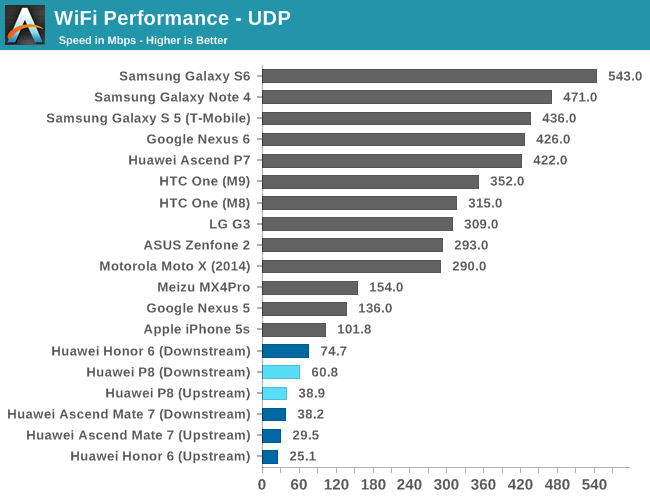
The Honor 6 and Mate 7's WiFi performances still leave a bitter taste due to their bad WiFi performances, and the P8 does little to sweeten the deal. Yet again we see atrocious numbers from the affected devices. A especially very weird characteristic that can only be found on the Huawei devices is that we see discrepancies between downstream and upstream transfer speeds, as transfers in the downstream direction are consistently faster than upstream data transfers.
I suspected there was some software reason as to why this happened back when reviewing the H6 and MT7, but couldn't confirm it as Huawei hadn't released the source code for the devices yet. Since then, they did manage to comply to GPL and make the kernel sources available.
While searching through Broadcom's DHD driver to see what changes Huawei/HiSilicon have made, one notable change that I stumbled upon, although not related to the bad WiFi speeds, was their network traffic DVFS mechanism. This has nowdays become quite of a standard in modern devices as vendors try to improve latency and response-time of devices. Most notably Samsung has a very robust framework that boosts CPU and memory frequency when detecting spikes in network and NAND throughput (Among others). It's interesting to see how these quality-of-service mechanism gain popularity among vendors.
In the end the software assumption just didn't work out. Simply gripping the phone in-hand will reduce the transfer speeds by a third, clearly pointing out that this is an antenna/RF issue and not a software bottleneck or bandwidth throttling.
GNS Performance
I wasn't able to fully determine what silicon provides the GPS functionality for the P8, but I suspect it is the Kirin SoC and its integrated Balong modem have a play in it.
No matter who provides the chip solution, the end-result is what counts. Here the P8 performs very well by being able to capture a large number of satellites at high strength. Cold lock-on without AGPS assistance took 39 seconds, while with pre-cached location data the P8 was able to have a location fix in under 3 seconds.
NAND Performance
NAND performance was again one of the weak spots of previous Huawei devices, with the H6 and MT7 using quite old eMMC units that were also used back in the Galaxy S3. The P8 remedies this by using a faster SanDisk SDW16G unit.
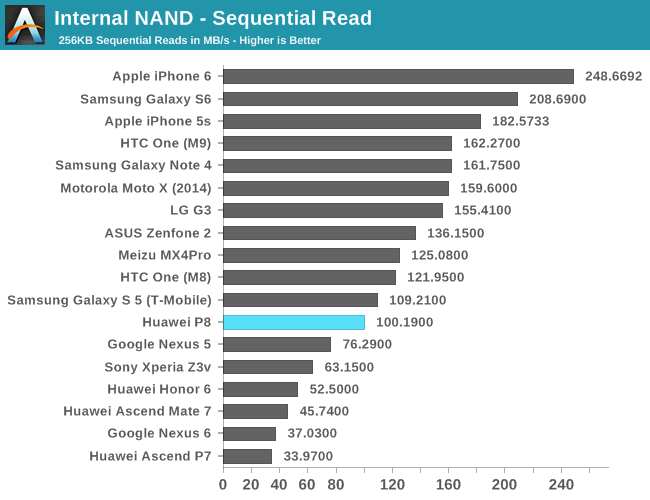
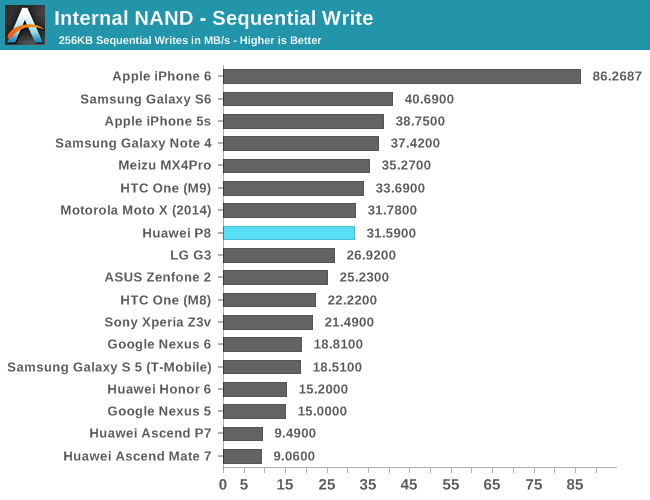
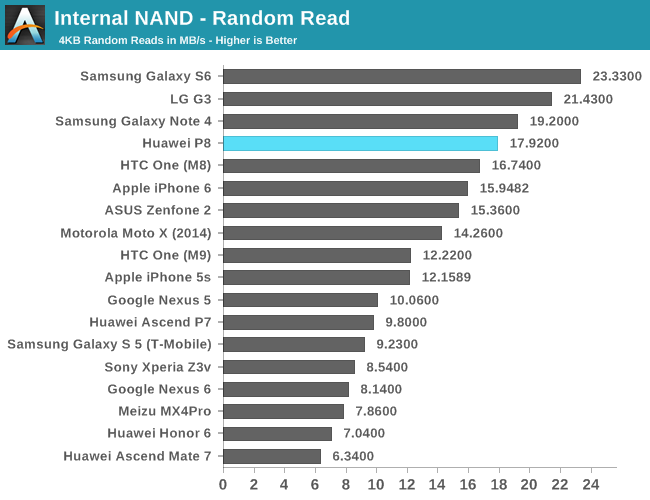
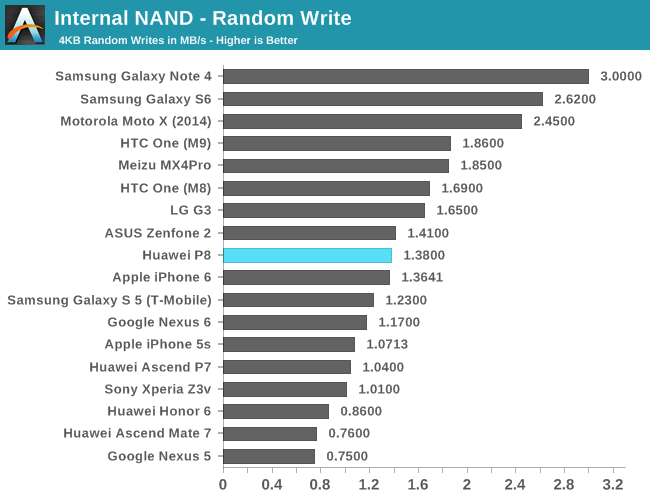
While the new eMMC doesn't break any records, it's now among the "average" performing devices out there, as opposed to the horrendous performances of the Mate 7 and Honor 6.











104 Comments
View All Comments
Ethos Evoss - Friday, June 12, 2015 - link
total bullshit..Brakken - Friday, June 5, 2015 - link
I'm curious - why would anyone buy something like this? Free can be had anywhere - even older models of iPhones can be had for free with a contract. These Chinese things offer nothing new, including underpowered hardware and unsupported software. I have to admit though - this thing beautifully blends the champhered edges of the iPh5 and the speaker grills of the iPh6/iPod5.Ethos Evoss - Friday, June 12, 2015 - link
I think u really need to visit eye surgery ! same edges like on iphone really ?? speaker grills same like on iP6 ?? ar u sure u not blind or u have completely blurred eyes???Have you ever seen the galaxy S6 or S6 edge and took a lok at its bottom of phone u EYE cripple?
sibuna - Monday, June 8, 2015 - link
its more of a Galaxy note clone than anything elseEthos Evoss - Friday, June 12, 2015 - link
u ar fkin d-headT1beriu - Thursday, June 4, 2015 - link
What are the chances of Huawei sending a phone with a cherry picked calibrated display?Andrei Frumusanu - Thursday, June 4, 2015 - link
Close to zero. This was one of the units they have out to all the attendees of the London launch event. Given the bad backlight bleed of this unit it's highly likely they're not picked. Plus I had to figure out myself that setting the temperature to minimum will make it accurate.cknobman - Thursday, June 4, 2015 - link
Slow CPU and GPUBad display
Poor camera
Slow charge time
Terrible WiFi performance
Not cheap
Is there any good reason to buy one of these things?
echoe - Thursday, June 4, 2015 - link
Did you read the review? Andrei said the camera's great, it's just everything else that's bad. Like so:"While the camera is the phone's truly outstanding feature, the whole device as a package just seems to underperform on too many other areas to be able to justify a purchase."
melgross - Thursday, June 4, 2015 - link
It's JUST everything else that's bad? That's a pretty damning statement, if you ask me. And the camera didn't perform all that well in the easiest situation—outdoors in sunlight. Not so great after all.